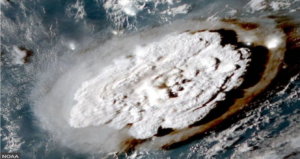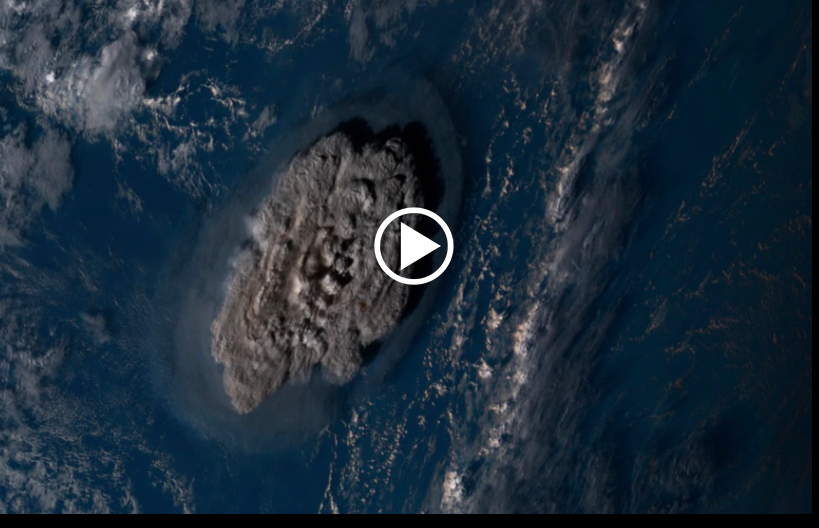The tsunami warning was issued Saturday (January 15) after a volcano at the bottom of the South Pacific Ocean erupted most violently in decades. The waves flooded the capital of the island nation of Tongan, the king rushed to evacuate, the people fled to high places

Volcano in the Pacific island nation of Tonga erupted on the evening of January 15. (Image source: National Oceanic and Atmospheric Administration, NOAA).
1.14.2022: (correction on date) Large volcanic eruption near Tonga (Hunga Tonga-Hunga Ha'apai volcano) today as seen from outer space. Shown on visible imagery using the Himawari satellite. #hiwx #tsunami #earthquake pic.twitter.com/Y18W7wvXl9
— NWSHonolulu (@NWSHonolulu) January 15, 2022
Satellite images show a huge ash cloud and shock waves traveling along with the eruption. The Tonga Geological Service said the gas, smoke and ash spewed from the volcano rose to an altitude of 20 kilometers (12.4 miles).
The violent eruption a few hours ago of the Hunga Tonga-Hunga Haʻapai volcano captured by satellites GOES-West and Himawari-8. pic.twitter.com/PzV5v9apF6
— Wonder of Science (@wonderofscience) January 15, 2022
CNN’s Radio New Zealand (RNZ) reported that the Hunga-Tonga-Hunga-Ha’apai volcano erupted for the first time on Friday. Sending a plume of volcanic ash 20 kilometers into the air. The volcano erupted for the second time at 5:26 pm on January 15, local time.
The volcano is about 30 kilometers southeast of the Tonga island of Fonuafo’ou. Tsunami warnings have been issued for the Tongan Islands and even New Zealand and Australia 2,300 kilometers away.
In addition to the tsunami warning, the Tonga Meteorological Department has issued warnings for heavy rain, flash floods and strong gusts of wind for the mainland and coastal waters.
The king and the people escaped one by one
On Saturday (January 15), waves crossed the coastline of Tonga’s capital Nuku’alofa, headed for coastal roads and engulfed homes. Tongatapu is the main island of the country, located 65 kilometers north of the volcano.
After the tsunami hit the capital, King Tupou VI of Tonga had to evacuate his palace and flee to a villa in Mata Ki Eua with a convoy of police and military forces. People ran to high places to avoid.
Mere Taufa, a Tongan resident, said she and her family were preparing to have dinner when the volcano erupted, and her brother thought a bomb had exploded nearby.
(Video from Yesterday January 14, 2022)
This was the first eruption of the Hunga-Tonga Hunga-Ha'apai Volcano The First Day (Friday, January 14)
#volcano #Tonga #HungaTonga #HungaTongaHungaHaapai #underwater #volcano#Tsunami #Tonga #Oceania pic.twitter.com/YN9dLIl3VA— Journalist Siraj Noorani (@sirajnoorani) January 15, 2022
New Zealand’s Stuff.co.nz news site quoted Mere Taufan as saying: “My first reaction was to hide under the table, I grabbed my sister and called out to my parents and the rest of the family.”
Then the water flooded into their house. “You can hear screams everywhere, people screaming for safety, calling to get higher together,” says Taufa.
Fiji One TV reporter Jese Tuisinu tweeted a video showing the waves crashing against the shore and people trying to get in their cars to avoid the oncoming waves. Witnesses said ashes fell all over the capital. Phone calls were also interrupted.
“Parts of Tonga were pitch black and people rushed for safety after the eruption,” Tusinu said.
Many countries warn of tsunamis
On January 15, the Japan Times reported that a tsunami hit several areas of the country’s coast in the Pacific Ocean. Minutes after authorities issued an emergency order for a 3-meter-high tsunami with the islands of Amami and Tokara, the first tsunami hit the Japanese coast. Tsunamis occurred in areas along the coast from Tohoku to Okinawa. In addition, Japanese authorities have also warned of less destruction for the entire stretch of Japan’s coast in the Pacific Ocean.
The Australian Bureau of Meteorology said that at 5:30pm local time on January 15, they recorded a 1.2m (about 4ft) tsunami near Nuku’alofa.
According to Reuters, the Pacific Tsunami Warning Center said the tsunami in Pago Pago, the capital of Samoa, was 0.6 meters (2 feet) high.
The Samoa Meteorological Agency said a tsunami warning was in effect for all low-lying coastal areas of Samoa. The agency said the public should avoid traveling to coastal areas.
Officials in the Fijian capital, Suva, said the volcano erupted violently in the first eight minutes, so powerful that “huge thunder” could be heard in Fiji more than 800 kilometers away. The Fijian government has issued a tsunami warning and opened evacuation centers for people in low-lying coastal areas.
The Pacific island nation of Vanuatu’s National Office of Disaster Management also said a tsunami warning was in effect and people were advised to stay away from the coast and head to higher ground.
New Zealand’s National Emergency Management Agency said a tsunami warning had also been issued for coastal areas off the north and east coasts of New Zealand’s North Island and Chatham Islands. In those areas, “strong, irregular and unpredictable currents” are forecast.
Largest volcanic eruption in 30 years
The volcano has been active since December 20, 2021, but was declared dormant on January 11.
This eruption is one of the largest eruptions in Tonga in 30 years, said Professor Shane Cronin, a volcanologist from the Auckland University of Technology.
He told the BBC: “It’s a pretty big event – it’s at least one of the most important eruptions of the last decade. Most notable is its expansion speed and ferocity. This time it was on a larger scale, spreading more horizontally and producing more ash. I expect the ash deposited in Tonga to be many centimeters thick.”
New Zealand’s official Meteorological Agency said that meteorological stations around the country had observed an “increased pressure” from the eruption on Saturday night (January 15).
According to the National Weather Service’s Pacific Tsunami Warning Center, the “distant eruption” posed no tsunami threat to Guam and the Commonwealth of Nations. the island of Northern Mariana; A tsunami warning for American Samoa was previously issued, then cancelled.
Earlier in late 2014 and early 2015, a series of volcanic eruptions in the area created a new small island and disrupted international flights to Tonga for several days.


